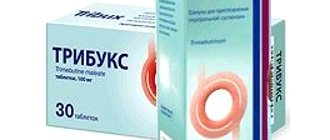Liprazid 10 tablets for high blood pressure, 30 pcs.
Non-melanoma skin cancer
An increased risk of nonmelanoma skin cancer (NMSC) with increasing cumulative dose of HCTZ was found in two pharmacoepidemiological studies. The photosensitizing effect of HCTZ may act as a possible mechanism for the development of this pathology.
Patients taking HCTZ alone or in combination with other drugs should be informed of the risk of developing NMSC, especially with long-term use, the need for regular skin checks, and to immediately report new lesions or any suspicious skin lesions, changes in skin lesions or moles.
To reduce the risk of developing skin cancer, patients should be advised of possible preventive measures, such as limiting exposure to sunlight and UV radiation, and if exposed, the need for adequate skin protection. It is necessary to examine suspicious skin lesions as soon as possible, including histological examination of biopsy material.
Patients with a previous history of NMSC may also need to review the use of HCTZ.
Symptomatic hypotension
Symptomatic hypotension is rare in patients with uncomplicated hypertension and is more likely in patients with hypovolemia, electrolyte imbalance (including hyponatremia, hypochloremic alkalosis, hypomagnesemia or hypokalemia), for example, during diuretic therapy, low-salt diet, dialysis, diarrhea , vomiting or in severe forms of renin-dependent hypertension. Such patients should undergo regular determination of serum electrolytes. In patients at increased risk of symptomatic hypotension, initiation of therapy and dose adjustment should be carried out under close medical supervision. Particular attention is necessary for patients with coronary heart disease or cerebrovascular diseases, in whom an excessive decrease in pressure can lead to myocardial infarction or stroke.
If arterial hypotension develops, the patient should be placed on his back and, if necessary, given an intravenous infusion of saline sodium chloride solution. Transient arterial hypotension when taking the drug is not a contraindication for its further use. After normalization of blood pressure and restoration of effective blood volume, it is possible to resume therapy with the drug lisinopril / hydrochlorothiazide in a reduced dosage or separately with one of the components.
In some patients with heart failure and normal or low blood pressure, lisinopril may further reduce systemic blood pressure. This effect is expected and is not usually a reason to stop treatment. If symptomatic hypotension may require dose reduction or discontinuation of the lisinopril/hydrochlorothiazide combination drug.
Dual blockade of renin-angiotensin (RAAS)
Concomitant use of ACE inhibitors (including lisinopril), angiotensin II receptor blockers (ARBs) or aliskiren increases the risk of arterial hypotension, hyperkalemia and decreased renal function (including acute renal failure). Therefore, dual blockade of the RAAS by combining ACE inhibitors with ARBs or aliskiren is not recommended.
If double blockade of the RAAS is considered absolutely necessary, this should only occur under specialist supervision and with frequent careful monitoring of renal function, blood electrolyte levels (especially potassium), and blood pressure.
ACE inhibitors and ARBs should not be used concomitantly in patients with diabetic nephropathy.
Previous diuretic therapy
Symptomatic hypotension may occur after the initial dose of the lisinopril/hydrochlorothiazide combination drug. This is more likely in patients with dehydration and/or salt deficiency as a result of previous diuretic therapy. Diuretic therapy should be discontinued 2-3 days before starting the lisinopril/hydrochlorothiazide combination. If this is not possible, treatment should be started with lisinopril 5 mg alone.
Aortic and/or mitral valve stenosis/hypertrophic cardiomyopathy
Like other ACE inhibitors, lisinopril is not recommended for use in patients with mitral valve stenosis and left ventricular outflow obstruction (for example, aortic stenosis or hypertrophic cardiomyopathy).
Renal dysfunction
Thiazides may not be acceptable diuretics for use in patients with impaired renal function. They are ineffective when CC is 30 ml/min or lower (moderate or severe renal failure).
The combination drug lisinopril/hydrochlorothiazide should not be used as initial therapy in any patient with impaired renal function.
Lisinopril/hydrochlorothiazide should not be prescribed to patients with renal impairment (creatinine clearance ≤ 80 ml/min) until the need for the exact doses contained in the combination tablet has been established by titrating the doses of the individual active substances of the drug.
In patients with heart failure, arterial hypotension that occurs after initiation of therapy with ACE inhibitors can lead to further impairment of renal function with the possible subsequent development of reversible (after discontinuation of the drug) acute renal failure.
Some patients with arterial hypertension without obvious signs of kidney disease may experience slight transient increases in serum urea and creatinine levels, especially if lisinopril is used concomitantly with diuretics. The likelihood of this happening is higher in patients with pre-existing renal impairment. This condition may require dose reduction and/or discontinuation of the diuretic and/or lisinopril.
Patients after kidney transplantation
There is no experience with the use of the drug in patients with a recently transplanted kidney, so the drug should not be used in this group of patients.
Anaphylactoid reactions during hemodialysis
The use of lisinopril/hydrochlorothiazide is not indicated in patients who require dialysis for renal failure.
Cases of anaphylactic reactions have been reported in patients undergoing hemodialysis procedures using high-flow membranes (for example AN 69) and concomitant treatment with ACE inhibitors. In such patients, it is recommended to use a different type of dialysis membrane or a different class of antihypertensive drugs.
Anaphylactoid reactions during low-density lipoprotein (LDL) apheresis
Life-threatening anaphylactic reactions have been rarely reported in patients receiving ACE inhibitors during LDL apheresis with dextran sulfate. To avoid these reactions, ACE inhibitors should be temporarily suspended before each apheresis procedure.
Liver diseases
Thiazides should be used with caution in patients with impaired liver function or progressive liver disease, since minor changes in fluid and electrolyte balance may precipitate sudden hepatic coma.
Very rarely, the use of ACE inhibitors has been associated with a syndrome that begins with cholestatic jaundice or hepatitis and progresses to fulminant hepatic necrosis, sometimes fatal. The mechanism of this syndrome is unknown. If patients taking lisinopril/hydrochlorothiazide develop jaundice or significantly increased serum liver enzymes, the drug should be discontinued and the patient should be monitored until symptoms resolve.
Surgery/general anesthesia
During major surgery or during anesthesia with drugs that cause hypotension, lisinopril can block the formation of angiotensin II due to compensatory release of renin, causing a pronounced, unexpected decrease in blood pressure. If arterial hypotension develops, which can be explained by this mechanism, it should be corrected by increasing the volume of blood volume.
Metabolic and endocrine effects
It is known that the combined use of ACE inhibitors and antidiabetic drugs (including insulin) can cause an increase in blood glucose concentrations and reduces the risk of hypoglycemia. This phenomenon is more likely to develop in the first weeks of combination therapy and in patients with impaired renal function (see Section “Interaction with other drugs and other types of interactions”). Thiazide therapy can lead to impaired glucose tolerance and the development of hyperglycemia. Therefore, dosage adjustments of antidiabetic agents, including insulin, may be necessary. In diabetic patients receiving oral antidiabetic agents or insulin, plasma glucose levels should be carefully monitored during the first month of treatment with an ACE inhibitor. Manifestation of latent diabetes mellitus is possible during thiazide therapy.
Thiazide diuretic therapy may be associated with increased levels of cholesterol, free bilirubin (due to displacement from albumin) and triglycerides in the blood plasma.
Thiazides can reduce plasma levels of protein-bound iodine without evidence of thyroid dysfunction.
In some patients, the use of thiazide diuretics may provoke hyperuricemia and/or worsen the course of/provoke an attack of gout in predisposed patients. However, lisinopril may increase the excretion of uric acid and thus may reduce the hyperuricemic effect of hydrochlorothiazide.
Electrolyte imbalance
All patients receiving diuretic therapy should have serum electrolyte levels measured periodically to identify possible fluid and electrolyte imbalances.
Thiazides, including hydrochlorothiazide, can cause water and electrolyte imbalance, incl. hypovolemia, hyponatremia, hypokalemia, hypomagnesemia, hypochloremic alkalosis. Determination of serum and urine electrolyte levels is especially important when the patient is experiencing excessive vomiting and/or diarrhea or is receiving parenteral fluids. Warning symptoms of fluid and electrolyte imbalance, regardless of the cause, are dry mouth, thirst, weakness, lethargy, drowsiness, restlessness, confusion, cramps, muscle pain or cramps (Crump), muscle fatigue, hypotension, oliguria, tachycardia, nausea , vomit.
The drug should be prescribed with caution to patients who are on a salt-free diet.
In patients with edema in hot weather, dilutional hyponatremia may occur. Chloride deficiency is usually minor and does not require treatment. Thiazides increase urinary excretion of magnesium, which can lead to hypomagnesemia.
Thiazides can also reduce the excretion of calcium in the urine and, as a result, cause a slight transient increase in its level in the blood plasma. Significant hypercalcemia may be a manifestation of latent hyperparathyroidism. Thiazides should be discontinued before testing parathyroid function.
Hyperkalemia
Some patients taking ACE inhibitors, including lisinopril, experienced an increase in serum potassium concentrations. Risk factors for hyperkalemia include renal failure, diabetes mellitus, concomitant use of potassium-sparing diuretics, potassium-containing dietary supplements or potassium-containing salt substitutes or other drugs that cause an increase in serum potassium concentrations (for example, heparin, trimethoprim). If taking the above-mentioned drugs during treatment with ACE inhibitors is considered necessary, regular monitoring of serum potassium levels is recommended.
Monitoring blood electrolyte levels is particularly important in patients receiving potassium-sparing diuretics and ACEIs or ARBs for heart failure. Also in such cases, the lowest effective doses of potassium-sparing diuretics and ACEIs/ARBs should be used. In case of hyperkalemia, suspension or discontinuation of treatment should be considered.
Diabetes
Patients taking oral antidiabetic agents or insulin should exercise close glycemic control, especially during the first month of treatment with ACE inhibitors.
Hypersensitivity/angioedema
Angioedema of the face, extremities, lips, tongue, epiglottis, vocal cords and/or larynx has been observed in isolated cases in patients treated with ACE inhibitors, including lisinopril. Angioedema may develop at any time during treatment. In this case, the use of lisinopril should be stopped immediately, appropriate treatment should be administered and the patient should be monitored until symptoms disappear completely.
Even in cases where swelling is limited to the tongue and there are no signs of respiratory distress, patients may require long-term observation as treatment with antihistamines and corticosteroids may not be sufficient.
Very rarely, deaths due to angioedema of the larynx or tongue have been reported. If swelling extends to the tongue, vocal cords, or larynx, airway obstruction may occur, especially in patients who have previously had respiratory surgery. In such cases, emergency treatment measures (administration of adrenaline (epinephrine) and/or maintaining airway patency) should be taken immediately. The patient should be under close medical supervision until symptoms disappear completely and permanently.
Angioedema with the use of ACE inhibitors occurred more often in representatives of the Negroid race than in patients of other races.
Patients with a history of angioedema not related to ACE inhibitor therapy may have an increased risk of developing it when using ACE inhibitors.
Patients receiving thiazides may experience hypersensitivity reactions (with or without a history of allergies or bronchial asthma). The use of the drug may worsen the course of connective tissue diseases, incl. systemic lupus erythematosus.
Anaphylactoid reactions during desensitization therapy
In patients receiving ACE inhibitors, prolonged anaphylactoid reactions developed during desensitizing therapy with allergens (for example, hymenoptera venom). By abstaining from taking ACE inhibitors during desensitization, such reactions can be avoided, but accidental repeated administration of ACE inhibitors again provoked the development of anaphylactoid reactions.
Neutropenia / agranulocytosis / thrombocytopenia / anemia
Cases of neutropenia/agranulocytosis, thrombocytopenia and anemia have been reported in patients taking ACE inhibitors. With normal renal function and in the absence of any other predisposing factors, neutropenia rarely develops. Neutropenia and agranulocytosis are reversible after discontinuation of ACE inhibitors.
Lisinopril should be used with particular caution in patients with diffuse connective tissue diseases, those being treated with immunosuppressants, allopurinol or procainamide, or a combination of these complicating factors, especially in the presence of pre-existing renal impairment.
Some of these patients developed severe infections that sometimes did not respond to intensive antibiotic therapy. When using lisinopril in such patients, it is recommended that the white blood cell count be periodically monitored, and patients should be warned to inform the physician of any signs of infection.
Choroidal effusion, acute myopia and secondary glaucoma
Hydrochlorothiazide, which is part of the drug, can cause an idiosyncratic reaction, which leads to the appearance of choroidal effusion with a visual field defect, the development of acute transient myopia and acute angle-closure glaucoma. Symptoms are characterized by an acute onset of decreased visual acuity and/or ocular pain and usually develop within hours to several weeks from the start of hydrochlorothiazide treatment.
Untreated acute glaucoma can lead to permanent vision loss. The first step is to stop using hydrochlorothiazide as soon as possible. Prompt medical or surgical treatment should subsequently be considered if intraocular pressure remains uncontrolled. A history of allergy to sulfonamides or penicillins may be a risk factor for the development of acute angle-closure glaucoma.
Ethnic characteristics
Blacks taking ACE inhibitors were more likely to experience angioedema compared to patients of other races. As with other ACE inhibitors, the antihypertensive effect of lisinopril is less pronounced in patients of the Black race than in patients of other races, possibly due to the greater prevalence of individuals with low blood renin levels among hypertensive Black patients.
Cough
During treatment with ACE inhibitors, the occurrence of a non-productive persistent cough has been reported, which resolves after discontinuation of the drug. Cough caused by ACE inhibitors should be differentiated from cough caused by other diseases.
Primary hyperaldosteronism
In patients suffering from primary hyperaldosteronism, ACE inhibitors are ineffective and should not be used in this group of patients.
Lithium
Concomitant use of lithium and lisinopril is generally not recommended.
Elderly patients
According to clinical studies, the effectiveness and tolerability of simultaneous use of lisinopril and hydrochlorothiazide were similar in both elderly patients and younger patients with arterial hypertension.
No dosage adjustment is required for elderly patients. If an elderly patient experiences decreased renal function, the initial dose of lisinopril should be adjusted (see "Renal failure").
Pregnancy
You should not start taking ACE inhibitors during pregnancy. If continued therapy with ACE inhibitors is considered necessary, patients planning pregnancy should be switched to alternative antihypertensive therapy with drugs that have an established safety profile for use during pregnancy. If pregnancy is diagnosed, treatment with ACE inhibitors should be stopped immediately and, if necessary, alternative therapy should be initiated (see Sections “Contraindications” and “Use during pregnancy or lactation”).
Photosensitivity
Photosensitivity reactions have been reported during treatment with thiazides. If photosensitivity occurs during treatment, it is recommended to discontinue the drug. If the doctor believes that the drug needs to be re-prescribed, it is recommended to protect areas of the body exposed to sunlight or artificial UV radiation and limit exposure to the sun.
Anti-doping test
The hydrochlorothiazide contained in this medicine may cause a false positive result in a doping test.
The antihypertensive effect of hydrochlorothiazide may be enhanced after sympathectomy.
During treatment with Liprazide, alcohol consumption is not recommended.
Directions for use and dosage
Liprazid should be taken orally, swallowing the tablets whole with a sufficient amount of liquid, once a day, preferably at the same time. If necessary, the tablet can be divided into parts. Eating does not affect the effectiveness of the drug.
The initial dose is usually 5-10 mg (for lisinopril). If the therapeutic effect is insufficient, after 1-2 weeks of treatment the dose is gradually increased. The average maintenance daily dose is 20 mg, the maximum allowable is 80 mg.
The initial dose for patients with impaired renal function (creatinine clearance more than 30 ml/minute) and patients with renovascular hypertension is 2.5 mg per day.
The doctor determines the duration of treatment individually for each patient.
Drug interactions
The action of Liprazide is enhanced by loop and thiazide diuretics; reduce - non-steroidal anti-inflammatory drugs, estrogens, potassium-sparing diuretics, potassium preparations, sympathomimetics, cyclosporine, sodium chloride solution.
Liprazide reduces the effectiveness of hypoglycemic agents and enhances the effectiveness of non-depolarizing muscle relaxants, tubocurarine.
In case of simultaneous use, Liprazide increases sensitivity to tubocurarine.
Tetracyclines, enterosorbents, antacids, cholestipol, cholestyramine reduce the absorption of the active ingredients of the drug.
Liprazide should not be used simultaneously with lithium preparations.
Possible adverse reactions when using Liprazide simultaneously with other drugs:
- Indomethacin, cyclosporine, potassium-sparing diuretics, potassium supplements - the risk of developing hyperkalemia;
- Digoxin – increased toxicity;
- Amantadine and lithium – slowing down their elimination from the body;
- Amiodarone – risk of arrhythmia;
- Methyldopa – development of intravascular hemolysis;
- Cardiac glycosides – the likelihood of developing hypokalemia;
- Barbiturates, narcotic drugs, ethyl alcohol - the risk of developing hypokalemia and orthostatic hypotension;
- Systemic glucocorticosteroids, cytostatic and immunosuppressive drugs, allopurinol, procainamide - the risk of developing leukopenia.




